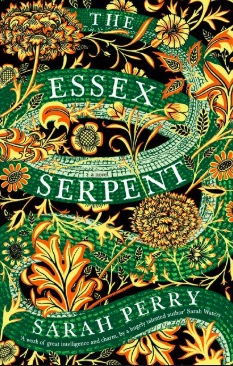Featuring memorable characters and a plot-driven story that explores themes of friendship, sexuality, and faith, this book is ripe for cottage consumption
Set in the late 1800s, The Essex Serpent tells the surprising story of recently widowed Cora Seaborne. She speaks plainly, prefers men’s clothing, and is obsessed with paleontology.
But Cora is not so distraught as one might expect when her husband dies of a tragic illness. In fact, she seems to be having a right jolly old time with her companion Martha and her son Francis following the funeral. Turns out her husband was abusive. She’s delighted to be free of his influence.
Cora, Martha, and Francis decamp from London to the wilds of Essex and becomes obsessed with making a sighting of a monstrous creature that is said to be lurking in the Blackwater estuary. Cora believes there’s might be a serpent but dismisses it as a demonic force, viewing it instead as a biological specimen that could be collected and studied.
When Cora meets William, a pastor who also has his reasons to deny the existence of a mythical monster, the two form an intellectual and social bond. But their friendship eventually develops into something more. William is torn between his attraction to Cora and his loyalty to his wife Stella, who just happens to be dying of tuberculosis.
Plot twists galore
The mystery of the serpent and the romantic tumult gives this book a binge-able quality that I loved. Better than any Netflix show. Like Cora and William, the reader is hungry to catch a glimpse of the big, black basilisk that seems to lurk just beneath the surface of the town’s collective consciousness.
Romantic subplots keep the story moving forward, too. Here’s a quick rundown: Spencer is in love with Martha. Martha is married to the cause of reducing poverty. Luke is in love with Cora. Cora is in love with William. William is in love with his dying wife Stella. All the comings and goings of unrequited love are very Victorian, and Perry uses these subplots effectively to create tension and keep the pages turning.
Vivid characters
But the real strength of The Essex Serpent is its characters. By challenging what readers expect from Victorian women, Perry has written a contemporary novel that challenges our ideas of what Victorian women cared about and how they acted.
Cora has the courage to live a life that defies our expectations of women. Satisfied by day-long walks in the wilds of Essex and her own self-directed study scientific papers of the day, her intellect is front and centre. Cora’s defiance of the rigid gender roles that are so fully explored in Victorian novels is surprising, but women like this did exist at the time, says the author.
“She was very firmly based on some vibrant, interesting, intellectual victorian women like Annie Besant and Eleanor Marx. And I wanted to reclaim the idea of Victorian women as not having been fainting onto a chaise longue waiting to be shouted at by their husbands, but by being politically active, intelligent, radical, fascinating women. Just like women are today.”
But it’s not just Cora. Every character in this book has a three-dimensional complexity. Martha, Luke, Spencer, Francis — each one is memorable and fully rendered.
I was disappointed with the character of William. While he seems completely devoted to God and his wife Stella throughout the book, he does finally consummate a relationship with Cora. But he doesn’t seem to suffer guilt following his lapse, and it seemed like a mere plot twist.
Like this review?
For more reading recommendations, sign up for my newsletter.

Published by